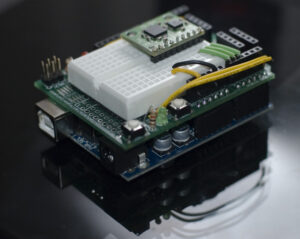 Fiber Bragg gratings or FBGs are considered to offer a markworthy application in the fastly growing aerospace industry. The FBG benefits such as phenomenal optical multiplexing make them possible to use as smart fiber optic sensors that allow them to perform structural health monitoring of airborne vehicles and maintain and lengthen their lifetime. Thus, FBG technology plays a crucial role in the spacecraft industry where tiny errors and damage can lead to death for the crew aboard.
Fiber Bragg gratings or FBGs are considered to offer a markworthy application in the fastly growing aerospace industry. The FBG benefits such as phenomenal optical multiplexing make them possible to use as smart fiber optic sensors that allow them to perform structural health monitoring of airborne vehicles and maintain and lengthen their lifetime. Thus, FBG technology plays a crucial role in the spacecraft industry where tiny errors and damage can lead to death for the crew aboard.
To be more precise, fiber Bragg grating is regarded as a thin, tubular optical fiber device that includes a physical “grating” area at its core. Herewith, the core of fiber Bragg gratings is not homogeneous, it has a periodic variation in the refractive material index. The principle of FBG technology operation is based on the change in the core refractive index because of which “some light will be reflected and some will be transmitted through the tube.” Additionally, the periodic spacing of the grating influences the reflected vs transmitted wavelength of light.
FBGs demonstrate efficient operation as narrow bandwidth light filters. The FBG application includes a block of specific wavelengths and transmission of others that is similar to the mode selection that appears in laser cavities. Nevertheless, such features as pressure and strain as well as vibration and displacement also influence the wavelengths of fiber Bragg gratings, while the temperature may lead to thermo-optic effects in the silica material that conventional FBG sensors are made from. Therefore, the mentioned FBG properties allow using them as fiber optic sensors to measure various physical effects at the same time.
FBG technology opens an opportunity to use FBG sensors to determine ultrasonic and acoustic wave signals, with a unique application in structural health monitoring of aerospace vehicles. The thing is that acousto-ultrasonic detection by fiber Bragg grating sensors is highly effective in damage detection if the spacecraft is not mobile (on the ground). Herewith, an ultrasonic actuator is required to produce the ultrasonic signals. It should be noted that the damage detection by FBG sensors is very accurate and quantitative because it allows controlling both the waveform function and the repetition of measurements.
Nevertheless, the limitations in resolution and bandwidth of conventional tools applied with fiber Bragg grating sensors, for example, optical spectrum analyzers, do not provide accuracy in high-frequency detection. It is necessary to use a demodulation method to interpret the detected signals for accurate detection of ultrasonic waves. Herewith, the installation technique of the fiber Bragg gratings is also important in ultrasonic detection. The installation of the fiber Bragg grating sensors into an aerospace vehicle or craft requires the use of various techniques. For example, it is possible to place FBGs into composite materials, however, it may cause signal distortion. This is the reason why a better way is gluing FBG sensors on with some adhesive, such as epoxy.
Optromix is a manufacturer of innovative fiber optic products for the global market. The company provides the most technologically advanced fiber optic solutions for the clients. Optromix produces a wide range of fiber optic devices, including cutting-edge customized fiber optic Bragg grating product line and fiber Bragg grating sensor systems. Moreover, Optromix is a top choice among the manufacturers of fiber Bragg grating monitoring systems. If you have any questions, please contact us at info@optromix.com


 The continuous development of high-temperature
The continuous development of high-temperature  Fiber Bragg grating technology
Fiber Bragg grating technology Nowadays the
Nowadays the  Fiber Bragg grating sensors
Fiber Bragg grating sensors Nowadays train accidents often cause severe injuries and even cases of death. Nevertheless, researchers from China have designed new
Nowadays train accidents often cause severe injuries and even cases of death. Nevertheless, researchers from China have designed new  Fiber optic inclinometer
Fiber optic inclinometer The researchers from NASA Armstrong Flight Research Center form a partnership with members of the Naval Surface Warfare Center to create fleet maintenance capabilities with the help of new
The researchers from NASA Armstrong Flight Research Center form a partnership with members of the Naval Surface Warfare Center to create fleet maintenance capabilities with the help of new  The
The